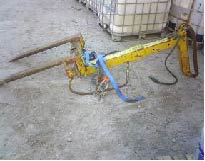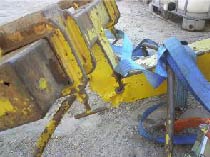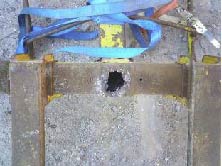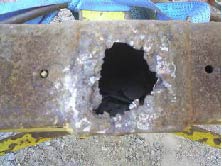Pallet lifter failure
A member has reported an incident in which a pallet lifting frame suffered a catastrophic failure. Various stores were being lifted onboard a company vessel during a recent mobilisation. A crate, containing a crane motor, was being lifted from the quayside on to the vessel deck; during this operation the pallet lifter being used suffered a catastrophic failure as the lift started. No one was injured.
The crate was observed to be tagged as weighing 1.6Te, and with a SWL of 2Te the pallet lifter was deemed suitable for the proposed lift. The pallet lifter was brought into place and the crate strapped around it. The lift was then started, with personnel standing clear, and when it was approximately 1m above the quayside the pallet lifter failed and the load dropped back to the quayside.
The pallet lifter had failed at a point on the stem near the forks, where it had buckled through 90°. The pallet lifter was disconnected and left on the quayside and the crate re-rigged and successfully lifted onboard.
Personnel involved in the lifting operation failed to inform vessel management at the time of the incident but later a report was made, though this was not received by the relevant vessel personnel until the following day, when an onboard investigation was begun.




Investigation proved difficult as most of the evidence had been removed. The crate had been sent off with the garbage and the tag indicating the weight of the load was not kept. The weight of the crane motor (the load which was dropped) was established at 1.4Te, proving that the pallet lifter had failed below its SWL of 2Te.
Further investigation of the pallet lifter revealed an area of corrosion on the underside of the forks where a hole had appeared. In addition the small hole on the otherwise smooth plate end of the cross beam indicated that deterioration was taking place inside and working outwards and would not have been evident unless the pallet lifter had been turned on its side. The pallet lifter had been inspected four months previously during the six-monthly rigging inspections and the corrosion was not identified. With the extent of the corrosion, some signs would have been evident during this inspection but were not spotted or highlighted.
Onboard personnel who had been using the equipment had also failed to identify that serious corrosion of the pallet lifter had occurred.
The following conclusions were drawn:
- The corrosion had weakened the structure to such an extent that the pallet lifter could not operate within its working limits. This highlights the fact that reliance on rigging certification is not enough and a regime of continued close and thorough monitoring of lifting equipment should be maintained at all times;
- The actual weight of the crate was not accurately known at any stage and this led to confusion. It was never verified at any stage prior to being lifted. The manifest detailed the weight at 3.2Te, the ID plate on the motor detailed the weight at 2.6Te, the tag showing 1.6Te was never in place as this was confused with an ID number and the actual weight was 1.4Te.
- It is imperative that weights are accurately known prior to carrying out a lift;
- The investigation was seriously hindered by the incident not being reported when it occurred;
- The pallet lifter inspection regime failed to identify the extent of the corrosion.
The following actions were recommended:
- Vessel crews should thoroughly check the condition of any pallet lifting devices they have onboard, with particular focus on the corrosion experienced by this unit. Any devices found to be in an unsatisfactory condition should be removed from service immediately and quarantined;
- Failure of lifting equipment should be reported immediately rather than 24 hours after occurrence, in order to enable an effective investigation to be carried out;
- Personnel involved in lifting operations should ensure that the weight of a load is accurately known prior to starting a lift; if there is any doubt or the information is not provided, the lift should be delayed until accurate information is found;
The pallet lifter inspection records and process were investigated separately as a result of this incident.
Safety Event
Published: 30 October 2008
Download: IMCA SF 16/08
IMCA Safety Flashes
Submit a Report
IMCA Safety Flashes summarise key safety matters and incidents, allowing lessons to be more easily learnt for the benefit of all. The effectiveness of the IMCA Safety Flash system depends on Members sharing information and so avoiding repeat incidents. Please consider adding safetyreports@imca-int.com to your internal distribution list for safety alerts or manually submitting information on incidents you consider may be relevant. All information is anonymised or sanitised, as appropriate.
IMCA’s store terms and conditions (https://www.imca-int.com/legal-notices/terms/) apply to all downloads from IMCA’s website, including this document.
IMCA makes every effort to ensure the accuracy and reliability of the data contained in the documents it publishes, but IMCA shall not be liable for any guidance and/or recommendation and/or statement herein contained. The information contained in this document does not fulfil or replace any individual’s or Member's legal, regulatory or other duties or obligations in respect of their operations. Individuals and Members remain solely responsible for the safe, lawful and proper conduct of their operations.
